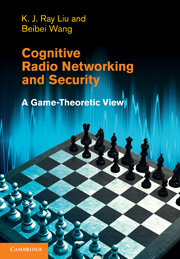Book contents
- Frontmatter
- Contents
- Preface
- Part I Cognitive radio communications and cooperation
- Part II Resource awareness and learning
- 10 Reinforcement learning for energy-aware communications
- 11 Repeated games and learning for packet forwarding
- 12 Dynamic pricing games for routing
- 13 Connectivity-aware network lifetime optimization
- 14 Connectivity-aware network maintenance and repair
- Part III Securing mechanism and strategies
- References
- Index
14 - Connectivity-aware network maintenance and repair
from Part II - Resource awareness and learning
Published online by Cambridge University Press: 06 December 2010
- Frontmatter
- Contents
- Preface
- Part I Cognitive radio communications and cooperation
- Part II Resource awareness and learning
- 10 Reinforcement learning for energy-aware communications
- 11 Repeated games and learning for packet forwarding
- 12 Dynamic pricing games for routing
- 13 Connectivity-aware network lifetime optimization
- 14 Connectivity-aware network maintenance and repair
- Part III Securing mechanism and strategies
- References
- Index
Summary
In this chapter we address the problem of network maintenance, in which we aim to maximize the lifetime of a sensor network by adding a set of relays to it. The network lifetime is defined as the time until the network becomes disconnected. The Fiedler value, which is the algebraic connectivity of a graph, is used as an indicator of the network's health. The network-maintenance problem is formulated as a semi-definite programming (SDP) optimization problem that can be solved efficiently in polynomial time. First, we present a network maintenance algorithm that obtains the SDP-based locations for a given set of relays. Second, we study a routing algorithm, namely the weighted minimum-power routing (WMPR) algorithm, that significantly increases the network lifetime due to the efficient utilization of the deployed relays. Third, we consider an adaptive network maintenance algorithm that relocates the deployed relays on the basis of the network health indicator. Further, we study the effect of two different transmission scenarios, with and without interference, on the network maintenance algorithm. Finally, we consider the network repair problem, in which we find the minimum number of relays together with their SDP-based locations needed in order to reconnect a disconnected network. We then present an iterative network repair algorithm that utilizes the network maintenance algorithm.
Introduction
There has been much interest in wireless sensor networks due to their various areas of application such as battlefield surveillance systems, target tracking, and industrial monitoring systems.
- Type
- Chapter
- Information
- Cognitive Radio Networking and SecurityA Game-Theoretic View, pp. 350 - 370Publisher: Cambridge University PressPrint publication year: 2010



